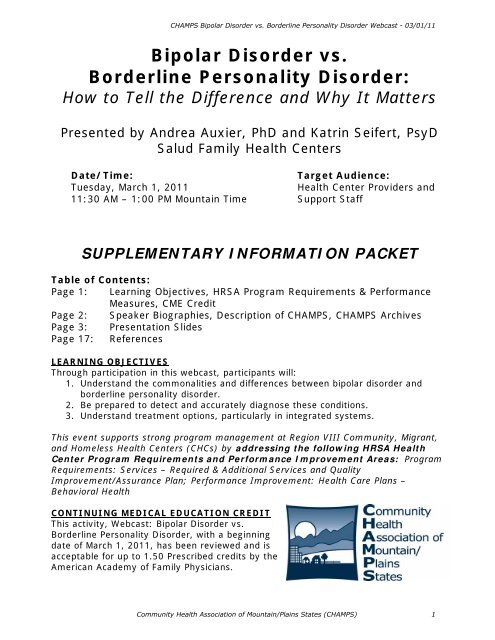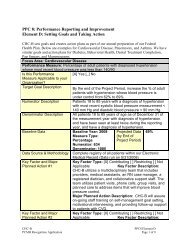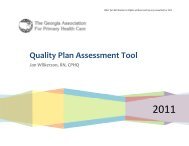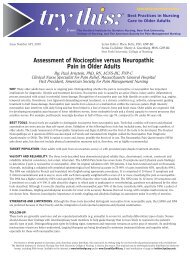Bipolar Disorder vs. Borderline Personality Disorder: - Community ...
Bipolar Disorder vs. Borderline Personality Disorder: - Community ...
Bipolar Disorder vs. Borderline Personality Disorder: - Community ...
You also want an ePaper? Increase the reach of your titles
YUMPU automatically turns print PDFs into web optimized ePapers that Google loves.
CHAMPS <strong>Bipolar</strong> <strong>Disorder</strong> <strong>vs</strong>. <strong>Borderline</strong> <strong>Personality</strong> <strong>Disorder</strong> Webcast - 03/01/11<strong>Bipolar</strong> Tx Outcomes• Therapy + meds better than treatment asusual• Addition of therapy had positive impact on sxs,adherence, QOL (although less robust at follow-up) (Gregory, 2010; Szentagotai & David, 2010)• Medication tx most effective whencontinuous, not start-stopstop (NIMH)• Less likely to recover if have comorbidmental illness (Perlis, et al., 2006)<strong>Bipolar</strong> <strong>Disorder</strong> <strong>vs</strong> <strong>Borderline</strong> <strong>Personality</strong> <strong>Disorder</strong>--March 1, 2011Atypical Antipsychotics andObesity/Diabetes• Obtain personal and family hx for diabetes,obesity, dyslipidemia, hypertension,cardiovascular disease• Get body mass index, waist circumference, BP,fasting glucose, fasting lipid• Reassess weight at 4, 8, 12 weeks after initiatingor changing antipsychotic then every 3 months• If patient gains more than 5% of initial weight,change medication(American Diabetes Association, American Psychiatric Association, AmericanAssociation of Clinical Endocrinologists, & North American Association for theStudy of Obesity, 2004)<strong>Bipolar</strong> <strong>Disorder</strong> <strong>vs</strong> <strong>Borderline</strong> <strong>Personality</strong> <strong>Disorder</strong>--March 1, 2011<strong>Bipolar</strong> in Children/Adolescents• Even in children, it is difficult to differentiatebetween mood swings of <strong>Bipolar</strong> <strong>Disorder</strong> andsymptoms of personality disorder (Mattes, 2010)• Often present with mixed or dysphoric picture withfrequent short periods of intense mood lability andirritability (Geller, et al., 1995; Wozniak, et al., 1995)• <strong>Bipolar</strong> in children:• Rapid cycling• Mixed episodes• Irritability• Multiple comorbidities (e.g. disruptive behavior andanxiety disorders) (Geller, et al., 2002; Mick, et al., 2003)<strong>Bipolar</strong> <strong>Disorder</strong> <strong>vs</strong> <strong>Borderline</strong> <strong>Personality</strong> <strong>Disorder</strong>--March 1, 2011<strong>Bipolar</strong> in Children• 69% of children with <strong>Bipolar</strong> also had Conduct<strong>Disorder</strong> (Kovacs & Pollock, 1995)• ADHD is most common comorbid dx (Kowatch, 2005)• Differential between <strong>Bipolar</strong> and ADHD:• For <strong>Bipolar</strong> must have elated mood orgrandiosity• Other sxs seen more in <strong>Bipolar</strong>:• Hypersexuality• Decreased need for sleep• Racing thoughts (Geller, et al., 2004)<strong>Bipolar</strong> <strong>Disorder</strong> <strong>vs</strong> <strong>Borderline</strong> <strong>Personality</strong> <strong>Disorder</strong>--March 1, 2011<strong>Bipolar</strong> in Children• Medical conditionsthat can mimicmania• Temporal lobe epilepsy• Hyperthyroidism• Head injury• MS• Systemic lupuserythematosus• Wilson’s disease(Kowatch, 2005)• Medications thatmay increase moodcycling• Antidepressants• Aminophylline• Corticosteroids• Sympathomimeticamines• AntibioticsMedication Tx of <strong>Bipolar</strong> in Children• General Guidelines• First stabilize mood then treatcomorbid disorders• Many start with antipsychotic orLithium• Often combine traditional moodstabilizer and atypical antipsychotic(Kowatch, 2005)<strong>Bipolar</strong> <strong>Disorder</strong> <strong>vs</strong> <strong>Borderline</strong> <strong>Personality</strong> <strong>Disorder</strong>--March 1, 2011<strong>Bipolar</strong> <strong>Disorder</strong> <strong>vs</strong> <strong>Borderline</strong> <strong>Personality</strong> <strong>Disorder</strong>--March 1, 2011<strong>Community</strong> Health Association of Mountain/Plains States (CHAMPS) 7
CHAMPS <strong>Bipolar</strong> <strong>Disorder</strong> <strong>vs</strong>. <strong>Borderline</strong> <strong>Personality</strong> <strong>Disorder</strong> Webcast - 03/01/11Relationships with OutsideAgenciesLCMH(Larimer)Health DistrictNRBH(Larimer)(Weld)SaludCRCMHCBBC(Adams)(Boulder)Centennial(Morgan & Logan)What’s Insufficient• A straight consultative model = lostopportunity for patient contact• Integration does not equal referral• Can’t reach entire population in 50-minute visits• There is no break in quality at 50minutes<strong>Bipolar</strong> <strong>Disorder</strong> <strong>vs</strong> <strong>Borderline</strong> <strong>Personality</strong> <strong>Disorder</strong>--March 1, 2011<strong>Bipolar</strong> <strong>Disorder</strong> <strong>vs</strong> <strong>Borderline</strong> <strong>Personality</strong> <strong>Disorder</strong>--March 1, 2011The Cost of Integration• Integration reduces costs - to apoint• Higher levels of integration costmoreFunding Integrated Care• Fee for service reimbursement isnot favorable to integrated systems• Meeting current carve-outrequirements would radically alterthe way we practice = fewerpatients seen; little integration<strong>Bipolar</strong> <strong>Disorder</strong> <strong>vs</strong> <strong>Borderline</strong> <strong>Personality</strong> <strong>Disorder</strong>--March 1, 2011<strong>Bipolar</strong> <strong>Disorder</strong> <strong>vs</strong> <strong>Borderline</strong> <strong>Personality</strong> <strong>Disorder</strong>--March 1, 2011Questions?Contact Info:aauxier@saludclinic.orgkseifert@saludclinic.orgThank You for Joining Us!Your opinions are very important to us.Please complete the event Evaluation for this webcast. If you are applying forContinuing Medical Education (CME) credit, you must complete the CME questionsfound at the end of the Evaluation.Only one person per computer may follow the link in the live eventto the online Evaluation/CME survey. Click on the “Link toEvaluation/CME Form” button to download a printable form or refer to the eventreminder email for a link to an additional online version of this form that can becompleted by others. (CHAMPS strongly encourages use of the online forms.)The AAFP invites comments on any activity that has been approved for AAFP CMEcredit. Please forward your comments on the quality of this activity tocmecomment@aafp.org.Visit www.CHAMPSonline.org/Events/DistanceLearning.htmlinformation about other live and archived CHAMPS webcasts.<strong>Bipolar</strong> <strong>Disorder</strong> <strong>vs</strong> <strong>Borderline</strong> <strong>Personality</strong> <strong>Disorder</strong>--March 1, 2011<strong>Bipolar</strong> <strong>Disorder</strong> <strong>vs</strong> <strong>Borderline</strong> <strong>Personality</strong> <strong>Disorder</strong>--March 1, 2011<strong>Community</strong> Health Association of Mountain/Plains States (CHAMPS) 16
CHAMPS <strong>Bipolar</strong> <strong>Disorder</strong> <strong>vs</strong>. <strong>Borderline</strong> <strong>Personality</strong> <strong>Disorder</strong> Webcast - 03/01/11<strong>Bipolar</strong> <strong>Disorder</strong> <strong>vs</strong>. <strong>Borderline</strong> <strong>Personality</strong> <strong>Disorder</strong>:How to Tell the Difference & Why it MattersReferencesAbood, Z., Sharkey, A., Webb, M., Kelly, A., & Gill, M. (2002). Are patients with bipolar disordersocially disadvantaged? A comparison with a control group. <strong>Bipolar</strong> <strong>Disorder</strong>s, 4, 243-248.American Diabetes Association, American Psychiatric Association, American Association ofClinical Endocrinologists, & North American Association for the Study of Obesity. (2004).Consensus development conference on antipsychotic drugs and obesity and diabetes. DiabetesCare, 27, 596-601.American Psychiatric Association. (2000). Diagnostic and statistical manual of mental disorders(4th ed., text rev.). Washington, DC: Author.Arnone, D., Cavanagh, J., Gerber, D., Lawrie, S.M., Ebmeier, K.P., & McIntosh, A.M. (2009).Magnetic resonance imaging studies in bipolar disorder and schizophrenia: Meta-analysis. BritishJournal of Psychiatry, 195, 194-201.Arnone, D., McIntosh, A.M., Chandra, P, & Ebmeier, K.P. (2008). Meta-analysis of magneticresonance imaging studies of the corpus callosum in bipolar disorder. Acta PsychiatricaScandinavic, 118, 357-362.Battle, C.L., Shea, M., Johnson, D.M., Yen, S., Zlotnick, C., Anarini, M.C., Sanislow, C.A., et al.(2004). Childhood maltreatment associated with adult personality disorders: Findings from thecollaborative longitudinal personality disorders study. Journal of <strong>Personality</strong> <strong>Disorder</strong>s, 18, 193-211.Beyer, J.L., Young, R., Kuchibhatla, M., & Krishnan, K.R. (2009). Hyperintense MRI lesions inbipolar disorder: A meta-analysis and review. International Review of Psychiatry, 21, 394-409.Beynon, S., Soares-Weiser, K., Woolacott, N., Duffy, S., & Geddes, J.R. (2009). Pharmacologicalinterventions for the prevention of relapse in bipolar disorder: A systematic review of controlledtrials. Journal of Psychopharmacology, 23, 574-591.Bizzarri, J.V., Sbrana, A., Rucci, P., Ravni, L., Massei, G.J., Gonnelli, C., et al. (2007). Thespectrum of substance abuse in bipolar disorder: Reasons for use, sensation seeking andsubstance sensitivity. <strong>Bipolar</strong> <strong>Disorder</strong>s, 9, 213-220.Bond, D.J., Lam, R.W., & Yatham, L.N. (2010). Divalproex sodium versus placebo in thetreatment of bipolar depression: A systematic review and meta-analysis. Journal of Affective<strong>Disorder</strong>s, 124, 228-234.Byers, A.L., Yaffe, K., Covinsky, K.E., Friedman, M.B., & Bruce, M.L. (2010). High occurrence ofmood and anxiety disorders among older adults. Archives of General Psychiatry, 67, 489-496.Chavira, D.A., Grilo, C.M., Shea, M.T., Yen, S., Gunderson, J.G., Morey, L.C., et al. (2003).Ethnicity and four personality disorders. Comprehensive Psychiatry, 44, 483-491.Clarkin, J.F., Yeomans, F., & Kernberg, O.F. (2006). Psychotherapy of borderline personality:Focusing on object relations. Washington, DC: American Psychiatric Press.<strong>Community</strong> Health Association of Mountain/Plains States (CHAMPS) 17
CHAMPS <strong>Bipolar</strong> <strong>Disorder</strong> <strong>vs</strong>. <strong>Borderline</strong> <strong>Personality</strong> <strong>Disorder</strong> Webcast - 03/01/11References, continuedCohen, P., Chen, H., Gordon, K., Johnson, J., Brook, J., & Kasen, S. (2008). Socioeconomicbackground and the developmental course of schizotypal and borderline personality disordersymptoms. Development and Psychopathology, 20, 633-650.Cruz, N., Sanchez-Moreno, J., Torres, F., Goikolea, J.M., Valenti, M., & Vieta, E. (2010). Efficacyof modern antipsychotics in placebo-controlled trials in bipolar depression: A meta-analysis.International Journal of Neuropsychopharmacology, 13, 5-14.Diflorio, A. & Jones, I. (2010). Is sex important? Gender differences in bipolar disorder.International Review of Psychiatry, 22, 437-452.Dikeos, D., Badr, M.G., Yang, F., Pesek, M.B., Fabian, Z., Tapia-Paniaqua, G., et al. (2010).Twelve-month prospective, multinational, observational study of factors associated withrecovery from mania in bipolar disorder in patients treated with atypical antipsychotics. WorldJournal of Biological Psychiatry, 11, 667-676.Duberstein, P.R. & Conwell, Y. (1997). <strong>Personality</strong> disorders and completed suicide: Amethodological and conceptual review. Clinical Psychology: Science and Practice, 4, 359-376.Eubanks-Carter, C. & Goldfried, M.R. (2006). The impact of client sexual orientation and genderon clinical judgments and diagnosis of borderline personality disorder. Journal of ClinicalPsychology, 62, 751-770.Fonagy, P. & Bateman, A. (2008). The development of borderline personality disorder – Amentalizing model. Journal of <strong>Personality</strong> <strong>Disorder</strong>s, 22, 4-21.Frank, E. (2005). Treating <strong>Bipolar</strong> <strong>Disorder</strong>: A Clinician’s Guide to Interpersonal and SocialRhythm Therapy. New York: Guilford Press, Inc.Geddes, J.R., Calabrese, J.R., & Goodwin, G.M. (2009). Lamotrigine for treatment of bipolardepression: Independent meta-analysis and meta-regression of individual patient data from fiverandomized trials. British Journal of Psychiatry, 194, 4-9.Geller, B., Craney, J. L., Bolhofner, K., Nickelsburg, M. J., Williams, M., & Zimerman, B. (2002).Two-year prospective follow-up of children with a prepubertal and early adolescent bipolardisorder phenotype. American Journal of Psychiatry, 159, 927–933.Geller, B. & Luby, J. (1997). Child and adolescent bipolar disorder: A review of the past 10years. Journal of the American Academy of Child and Adolescent Psychiatry, 36, 1168-1176.Geller, B., Sun, K., Zimmerman, B., Luby, J., Frazier, J., & Williams, M. (1995). Complex andrapid-cycling in bipolar children and adolescents: A preliminary study. Journal of Affective<strong>Disorder</strong>s, 34, 259-268.Geller, B., Tillman, R., & Craney, J.L. (2004). Four-year prospective outcome and natural historyof mania in children with a prepubertal and early adolescent bipolar disorder phenotype.Archives of General Psychiatry, 61, 459-467.Ghaemi, S.N., Wingo, A.P., Filkowski, M.A., & Baldessarini, R.J. (2008). Long-termantidepressant treatment in bipolar disorder: Meta-analysis of benefits and risks. ActaPsychiatrica Scandinavica, 118, 347-356.Gregory, V.L., Jr. (2010). Cognitive-behavioral therapy for bipolar disorder: Implications forclinical social workers. Journal of Social Service Research, 36, 460-469.<strong>Community</strong> Health Association of Mountain/Plains States (CHAMPS) 18
CHAMPS <strong>Bipolar</strong> <strong>Disorder</strong> <strong>vs</strong>. <strong>Borderline</strong> <strong>Personality</strong> <strong>Disorder</strong> Webcast - 03/01/11References, continuedGunderson, L.G., Weinberg, I., Daversa, M.T., Kueppenbender, K.D., Zanarini, M.C., Shea, M.T.,et al. (2006). Descriptive and longitudinal observations on the relationship of borderlinepersonality disorder and bipolar disorder. American Journal of Psychiatry, 163, 1173-1178.Joffe, H., Cohen, L.S., Suppes, T., McLaughlin, W.L., Lavori, P., Adams, J.M., et al. (2006).Valproate is associated with new-onset oligoamenorrhea with hyperandrogenism in women withbipolar disorder. Biological Psychiatry, 59, 1078-1086.Kempton, M.J., Geddes, J.R., Ettinger, U., Williams, S.C., & Grasby, P.M. (2008). Meta-analysis,database, and meta-regression of 98 structural imaging studies in bipolar disorder. Archives ofGeneral Psychiatry, 65, 1017-1032.Ketter, T.A., Brookes, J.O., III, Hoblyn, J.C., Holland, A.A., Nam, J.Y., Culver, J.L., et al. (2010).Long-term effectiveness of quetiapine in bipolar disorder in a clinical setting. Journal ofPsychiatric Research, 44, 921-929.Kliem, S., Kroger, C., & Kosfelder, J. (2010). Dialectical behavior therapy for borderlinepersonality disorder: A meta-analysis using mixed-effects modeling. Journal of Consulting andClinical Psychology, 78, 936-951.Kovacs, M. & Pollock, M. (1995). <strong>Bipolar</strong> disorder and comorbid conduct disorder in childhoodand adolescence. Journal of the American Academy of Child and Adolescent Psychiatry, 34, 715-723.Kowatch, R.A., Youngstrom, E. A., Danielyan, A., & Findling, R. L. (2005). Review and metaanalysisof the phenomenology and clinical characteristics of mania in children and adolescents.<strong>Bipolar</strong> <strong>Disorder</strong>s, 7, 483–496.Kozloff, N., Cheung, A.H., Schaffer, A., Cairney, J., Dewa, C. Veldhuizen, S., et al. (2010).<strong>Bipolar</strong> disorder among adolescents and young adults: Results from an epidemiological sample.Journal of Affective <strong>Disorder</strong>s, 125, 350-354.Krishnan, K.R. (2005). Psychiatric and medical comorbidities of bipolar disorder. PsychosomaticMedicine, 67, 1-8.Kupfer, D.J. (2005). The increasing medical burden in bipolar disorder. Journal of the AmericanMedical Association, 293, 2528-2530.Lam, D.H., Burbeck, R., Wright, K., & Pilling, S. (2009). Psychological therapies in bipolardisorder: The effect of illness history on relapse prevention – a systematic review. <strong>Bipolar</strong><strong>Disorder</strong>s, 11, 474-482.Linehan, M.M. (1993a). Cognitive-behavioral treatment of borderline personality disorder. NewYork: Guilford Press.Linehan, M.M. (1993b). Skills training manual for treating borderline personality disorder. NewYork: Guilford Press.Marino, M.F. & Zanarini, M.C. (2001). Relationship between EDNOS and its subtypes andborderline personality disorder. International Journal of Eating <strong>Disorder</strong>s, 29, 349-353.Magill, C.A. (2004). The boundary between borderline personality disorder and bipolar disorder:Current concepts and challenges. Canadian Journal of Psychiatry, 49, 551-556.<strong>Community</strong> Health Association of Mountain/Plains States (CHAMPS) 19
CHAMPS <strong>Bipolar</strong> <strong>Disorder</strong> <strong>vs</strong>. <strong>Borderline</strong> <strong>Personality</strong> <strong>Disorder</strong> Webcast - 03/01/11References, continuedMarangell, L.B. (2008). Current issues: Women and bipolar disorder. Dialogues in ClinicalNeuroscience, 10, 229-238.Mattes, J.A. (2010). <strong>Bipolar</strong> disorder? Archives of General Psychiatry, 67, 1198.McGilloway, A., Hall, R.E., Lee, T., & Bhui, K.S. (2010). A systematic review of personalitydisorder, race, and ethnicity: Prevalence, aetiology, and treatment. BMC Psychiatry, 10, 33.Mick, E., Biederman, J., Pandina, G., & Faraone, S. V. (2003). A preliminary meta-analysis ofthe Child Behavior Checklist in pediatric bipolar disorder. Biological Psychiatry, 53, 1021–1027.Miklowitz, D.J., Otoo, M.W., Frank, E., Reilly-Harrington, N.A., Wisniewski, S.R., Kogan, J.N., etal. (2007). Psychosocial treatments for bipolar depression: A 1-year randomized trial from theSystematic Treatment Enhancement Program (STEP). Archives of General Psychiatry, 64, 419-426.Mueser, K.T., Goodman, L.B., Trumbetta, S.L., Rosenberg, S.D., Osher, C., Vidaver, R., et al.(1998). Trauma and posttraumatic stress disorder in severe mental illness. Journal of Consultingand Clinical Psychology , 66, 493-499.Mukherjee, S., Shukla, S., Woodle, J., Rosen, A.M., & Olarte, S. (1983). Misdiagnosis ofschizophrenia in bipolar patients: A multiethnic comparison. American Journal of Psychiatry,140, 1571-1574.Newport, D.J., Stowe, Z.N., Viguera, A.C., Calamaras, M.R., Juric, S., Knight, B., et al. (2008).Lamotrigine in bipolar disorder: Efficacy during pregnancy. <strong>Bipolar</strong> <strong>Disorder</strong>s, 10, 432-436.NIMH, <strong>Bipolar</strong> <strong>Disorder</strong>, http://www.nimh.nih.gov/health/publications/bipolar-disorder/nimhbipolar-adults.pdf,accessed 1/4/11O’Donovan, C., Kusumakar, V., & Graves, G.R. (2002). Menstrual abnormalities and polycycticovary syndrome in women taking valproate for bipolar mood disorder. Journal of ClinicalPsychiatry, 63, 322-330.Paris, J., Gunderson, J., & Weinberg, I. (2007). The interface between borderline personalitydisorder and bipolar spectrum disorders. Comprehensive Psychiatry, 48, 145-154.Perlis, R. H., Miyahara, S., Marangell, L. B., Wisniewski, S. R., Ostacher, M., DelBello, M. P., &Nierenberg, A. A. (2004). Long-term implications of early onset in bipolar disorder: Data fromthe first 1000 participants in the systematic treatment enhancement program for bipolardisorder (STEP-BD). Biological Psychiatry, 55, 9, 875–881Perlis, R.H., Ostacher, M.J., Patel, J.K., Marangell, L.B., Zhang, H., Wisniewski, S.R., et al.(2006). Predictors of recurrence in bipolar disorder: Primary outcomes from the SystematicTreatment Enhancement Program for <strong>Bipolar</strong> <strong>Disorder</strong> (STEP-BD). American Journal ofPsychiatry, 163, 217-224.Perron, B.E., Fries, L.E., Kilbourne, A.M., Vaughn, M.G., & Bauer, M.S. (2010). Racial/ethnicgroup differences in bipolar symptomatology in a community sample of persons with bipolar Idisorder. Journal of Nervous and Mental Disease, 198, 16-21.<strong>Community</strong> Health Association of Mountain/Plains States (CHAMPS) 20
CHAMPS <strong>Bipolar</strong> <strong>Disorder</strong> <strong>vs</strong>. <strong>Borderline</strong> <strong>Personality</strong> <strong>Disorder</strong> Webcast - 03/01/11References, continuedReich, D.B. & Zanarini, M.D. (2008). Sexual orientation and relationship choice in borderlinepersonality disorder over ten years of prospective follow-up. Journal of <strong>Personality</strong> <strong>Disorder</strong>s,22, 564-572.Scheffer, R., Kowatch, R., Carmody, T., & Rush, A.J. (2005). A randomized placebo-controlledtrial of Adderall for symptoms of comorbid ADHD in pediatric bipolar disorder following moodstabilization with divalproex sodium. American Journal of Psychiatry, 162, 58-64.Selby, E.A. & Joiner, T.E. (2008). Ethnic variations in the structure of borderline personalitydisorder symptomatology. Journal of Psychiatric Research, 43, 115-123.Skodol, A.E., Gunderson, J.G., Pfohl, B., Widiger, T.A., Livesley, W.J., & Siever, L.J. (2002). Theborderline diagnosis I: Psychopathology, comorbidity, and personality structure. BiologicalPsychiatry, 51, 936-950.Skodol, A.E., Oldham, J.M., & Gallaher, P.E. (1999). Axis II comorbidity of substance usedisorders among patients referred for treatment of personality disorders. American Journal ofPsychiatry, 156, 733-738.Smith, D.J., Muir, W.J., & Blackwood, D.H. (2004). Is borderline personality disorder part of thebipolar spectrum? Harvard Review of Psychiatry, 12, 133-139.Smith, L.A., Cornelius, V.R., Azorin, J.M., Perugi, G., Vieta, E., Young, A.H., & Bowden, C.L.(2010). Valproate for the treatment of acute bipolar depression: Systematic review and metaanalysis.Journal of Affective <strong>Disorder</strong>s, 122, 1-9.Stiglmayer, C.E., Grathwol, T., Linehan, M.M., Ihorst, G., Fahrenberg, J., & Bohus, M. (2003).Aversive tension in patients with borderline personality disorder: A computer-based controlledfield study. Acta Psychiatrica Scandinavica, 111, 372-379.Strakowski, S.M., Sax, K.W., McElroy, S.L., Keck, P.E., Jr., Hawkins, J.M., & West, S.A. (1998).Course of psychiatric and substance abuse syndromes co-occurring with bipolar disorder after afirst psychiatric hospitalization. Journal of Clinical Psychiatry, 59, 465-471.Szentagotai, A. & David, D. (2010). The efficacy of cognitive-behavioral therapy in bipolardisorder: A quantitative meta-analysis. Journal of Clinical Psychiatry, 71, 66-72.Tang, C., Yeh, C., Huang, Y., Wang, L., Chou, W., Chou, M, & Chen, C. (2010). Long-termeffectiveness of aripiprazole in adolescents and young adults with bipolar disorder: A naturalisticstudy. International Journal of Psychiatry in Clinical Practice, 13, 252-256.Torgerson, S., Kringlen, E., & Cramer, V. (2001). The prevalence of personality disorders in acommunity sample. Archives of General Psychiatry, 58, 590-596.Trull, T.J., Sher, K.J., Minks-Brown, C., Durbin, J., & Burr, R. (2000). <strong>Borderline</strong> personalitydisorder and substance use disorders: A review and integration. Clinical Psychology Review, 20,235-353.Tsuchiya, K.J., Agerbo, E., Byrne, M., & Mortensen, P.D. (2004). Higher socio-economic status ofparents may increase risk for bipolar disorder in the offspring. Psychological Medicine, 34, 787-793.<strong>Community</strong> Health Association of Mountain/Plains States (CHAMPS) 21
CHAMPS <strong>Bipolar</strong> <strong>Disorder</strong> <strong>vs</strong>. <strong>Borderline</strong> <strong>Personality</strong> <strong>Disorder</strong> Webcast - 03/01/11References, continuedVainionpaa, L.K., Rattya, J., Knip, M., Tapanainne, J.S., Pakarinen, A.J., Lanning, P., et al.(1999). Valproate-induced hyperandrogenism during pubertal maturation in girls with epilepsy.Annals of Neurology, 45, 444-450.Viguera, A.C., Whitfield, T., Baldessarini, R.J., Newport, J., Stowe, Z, Reminick, A., et al. (2007).Risk of recurrence in women with bipolar disorder during pregnancy: Prospective study of moodstabilizer discontinuation. American Journal of Psychiatry, 164, 1817-1824.Vita, A., De Peri, L., & Sacchetti, E. (2009). Gray matter, white matter, brain, and intracranialvolumes in first-episode bipolar disorder: A meta-analysis of magnetic resonance imagingstudies. <strong>Bipolar</strong> disorders, 11, 807-814.Wilson, S.T., Stanley, B., Oquendo, M.A., Goldberg, P., Zalsman, G., & Mann, J.J. (2007).Comparing impulsiveness, hostility, and depression in borderline personality disorder and bipolarII disorder. Journal of Clinical Psychiatry, 68, 1533-1539.Wozniak, J., Biederman, J., & Kiely, K. (1995). Mania-like symptoms suggestive of childhoodonsetbipolar disorder in clinically referred children. Journal of the American Academy of Childand Adolescent Psychiatry, 34, 867-876.Yonkers, K.A., Wisner, K.L., Stowe, Z., Leibenluft, E., Cohen, L., Miller, L., et al. (2004).Management of bipolar disorder during pregnancy and the postpartum period. American Journalof Psychiatry, 161, 608-620.Young, J.E. (1994). Cognitive therapy for personality disorders: A schema-focused approach.Sarasota, FL: Professional Resource Press.Zanarini, M.C., Frankenburg, F.R., Hennen, J., & Silk, K.R. (2003). The longitudinal course ofborderline psychopathology: 6-year prospective follow-up of the phenomenology of borderlinepersonality disorder. American Journal of Psychiatry, 160, 274-283.Zanarini, M.C., Williams, A.A., Lewish, R.E., Reich, R.B., Vera, S.C. Marino, M.F., et al. (1997).Reported pathological childhood experiences associated with the development of borderlinepersonality disorder. American Journal of Psychiatry, 154, 1101-1106.<strong>Community</strong> Health Association of Mountain/Plains States (CHAMPS) 22
















